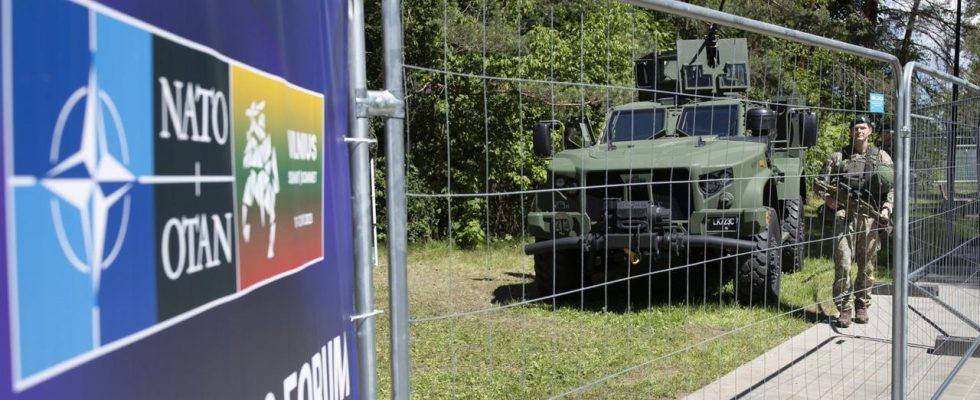background
A perspective for Ukraine and Sweden, higher defense spending by member states and pipeline protection – wide-ranging and sensitive issues are on the agenda of the NATO summit in Vilnius. Stephen Ueberbach with an overview.
The Ukraine Aid
Of course, this summit should also send a signal of solidarity. The NATO countries will continue to support the Ukrainian army’s defensive struggle with modern weapon systems, equipment and ammunition. President Volodymyr Zelenskyy, who is likely to be present in Vilnius, can probably not expect more than a year-long aid program. The desired official invitation to Ukraine to join the alliance will not be forthcoming in the foreseeable future, nor will there be a concrete roadmap for admission, which the Baltic states in particular would like to see.
Instead, NATO wants to strengthen Ukraine’s alliance perspective and give the government in Kiev more say on an equal footing. To this end, a NATO-Ukraine Council will be set up, which will meet in Vilnius for the first time. There is also talk of abandoning the usual pre-accession programme. However, Ukraine will only have a chance of becoming a member of NATO once the war is over.
The money
How much do the NATO countries want and should they spend on defense in the future? In 2014, the alliance partners agreed to invest two percent of their economic output in armaments by next year at the latest. So far eleven out of 31 Allies have achieved this goal. Most, including Germany, are still a long way off. In Vilnius, Secretary General Jens Stoltenberg wants to oblige the alliance partners to invest significantly more in their military than before in view of the Russian attack on Ukraine, thereby strengthening the alliance’s deterrence and defense capabilities.
Two percent should be the lower limit in the future. The NATO countries agreed on this in the run-up to the meeting. Germany intends to meet the alliance’s requirements next year. When the 100 billion euro special fund for the Bundeswehr is used up, i.e. probably from 2027, the defense budget will have to be increased significantly.
The North Extension
Actually, 32 allies were supposed to be sitting at the table in Vilnius for the first time. But unlike Finland, which became a full NATO member in April, neighboring Sweden has not yet received the green light. Turkey refused to agree to accession. The surprise on the eve of the summit: Turkish President Recep Tayyip Erdogan gave up his blockade, as Stoltenberg announced. Erdogan has agreed to submit the accession protocol to the Turkish parliament as soon as possible, said the NATO Secretary General after talks with the Turkish head of state and Swedish Prime Minister Ulf Kristersson.
Shortly before his departure, Erdogan had demanded that Turkey’s accession talks to the EU be resumed in return. If Turkey’s path to the EU is paved, Sweden’s path to NATO will also be paved, he said.
Hungary has also been on the brakes so far. Why was unclear. However, the country had also declared that it would not stand in the way of Sweden’s admission should Turkey give the green light. Stoltenberg said in the evening that Hungary had made it clear that the country did not want to be the last to agree to Sweden’s application for membership.
The force structure
At the Madrid summit a year ago, in response to Russia’s war of aggression, NATO decided to strengthen its combat units in the eastern member states and initiated the build-up of a 300,000-strong stand-by force. In Vilnius, the alliance decides on a new structure for the armed forces.
Three regional plans aim to ensure that there are always enough soldiers, weapons and equipment to defend specific areas against possible attacks – in the far north, from the Baltic to the Alps and from the Mediterranean to the Black Sea coast. The announced stationing of a 5,000-strong Bundeswehr brigade in Lithuania is taken into account. Christopher Cavoli, NATO Commander-in-Chief in Europe, wants the greatest possible flexibility. This means that the troops must be able to be deployed quickly in an emergency.
The protection of pipelines
Another topic at the NATO meeting will be the question of how the so-called critical infrastructure can be better protected. This primarily involves electricity and data lines as well as oil and gas pipelines that lie on the seabed and, as the example of Nord Stream 2 has shown, are possible targets for attacks. NATO has already set up a new coordination office to improve communication between the military alliance, national governments and the private sector operators of the lines. However, gas pipelines with a total length of 9,000 kilometers run through the North Sea alone. NATO will therefore not be able to guarantee 100% security.

